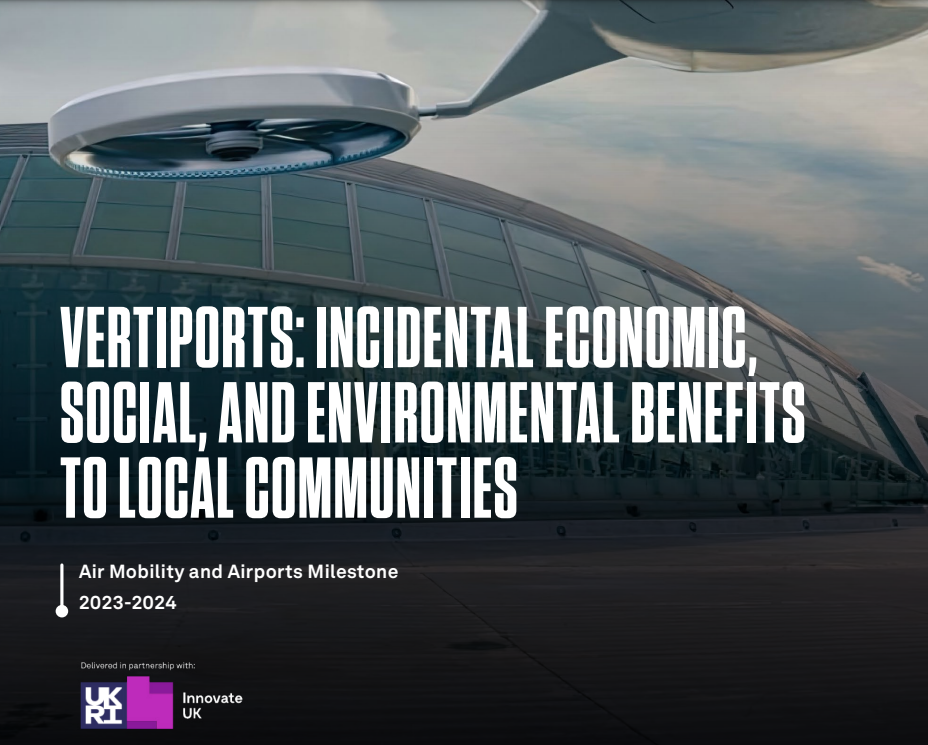
The UK’s Connected Place Catapult research agency has published a study Vertiports: Incidental economic, social and environmental benefits to local economies which identifies the incidental benefits that vertiports will bring to local communities.
According to the report: “improved transport connectivity will enable access to more jobs over a larger geography; access to out-of-town services, such as shopping, education, and specialist medicine will contribute towards the local population’s standard of living and better health outcomes. Reduced congestion, noise, and emissions on surface transportation as travellers switch to AAM. Enhanced attractiveness and competitiveness of the local area for businesses and residents with, for example, freight and logistics firms setting up near rural-based vertiports where land is cheaper. Potential to save more lives during emergencies, with time-critical patients transported to hospitals.”
The report also looks at how these impacts may vary depending on the location of the vertiport, with four case studies: a city centre, a shopping centre, a rural area, and a small airfield.
“AAM and building vertiports will improve connectivity. For areas that are currently underserved by conventional transport modes, this will have incidental benefits such as providing people with access to more jobs and services, leading to improvements in income and reductions in health inequality between communities,” said the report.
“For other areas that are already well connected, vertiports represent a (comparatively) cheaper, flexible, and scalable transport investment that could alleviate pressure points such as congestion in existing networks. As some travellers switch to AAM, the reduction in congestion will improve the efficiency of traditional modes such as road and rail, with falling GHG emissions also benefiting the environment.
“The incidental benefits of vertiports have also been considered in case studies based on four vertiport locations: a city centre, an out-of-town shopping centre, a rural area, and a small airfield. In each case, a vertiport would benefit the local area’s prosperity such as accelerating the decarbonisation of transport by replacing fossil fuel-based with electric and driving local economic growth. As there are no vertiports currently operating commercially, the scale of these impacts is difficult to quantify at this stage and attempting to do so based on our assumptions may lead to over or under-confidence in their potential. Furthermore, the extent to which these benefits will be unlocked is dependent on the ability of AAM overall to integrate into the transport network as a suitable mode of transportation.
“The larger the role that AAM plays in future transport, the larger the scale of the impacts described throughout this report will be. Nonetheless, there are some key enabling factors to vertiports’ success that stakeholders should consider. The most important is location – vertiports need to be close enough to population and business centres where their use is desired, but not too close that eVTOL flights inconvenience the public. They will also be more successful if they are closely linked with other transport modes, such as train and bus stations and airports. Vertiport companies should also work with Local Authorities and businesses to encourage economic activity in their surrounding area, such that the vertiport can be a part of redevelopment schemes to open new opportunities.
“Vertiports should be open access and multipurpose – segmenting the market between different operating companies and uses will stifle competition and growth. In future, as vertiports begin trials and initial operations, it is recommended that these impacts are re-considered and (where possible) quantified. This will help local governments and regulators better understand developing planning approval requirements and to permit them to work with vertiport companies to mitigate any negative impacts. It will also help build public support if local communities recognise the opportunities they provide. In addition, vertiport developers should engage with the public and local communities to understand and address their concerns and to help gain their support. Overall, as AAM is still in its infancy, it needs to be adaptable and respond positively to challenges in order to successfully develop and have maximum positive impact. If it does this, it has the potential to provide a range of benefits to transport users, local communities, and other stakeholders. It is recommended that the findings of this report be continually reviewed and updated as clarity emerges on vertiports and AAM move into the aviation market for commercial use.”
For more information
https://cp.catapult.org.uk/report/vertiports-incidental-economic-social-and-environmental-benefits-to-local-communities/

